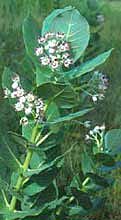View crop
View crop Data sheet EcoPortCalotropis procera
 |
|
| Notes |
|---|
| DESCRIPTION: It is a shrub or small tree reaching 2.5-6 m in height, stem usually simple, rarely branched, woody at base and covered with a fissured, corky bark. All parts of the plant exude a white latex when cut or broken. USE: Young pods, senescing leaves and flowers can be used as fed. Stems produce a good charcoal. The stem produces durable fibre used for various purposes. The very light wood can also be used for floats for fishing nets. Latex, rubber, tannin and dye can be obtained from the tree. The bark and the latex are widely used as arrow and spear poisons. Bark, wood, root bark and the sap have medicinal properties. A source of green manure. The plant can help improve soil water conditions and also acts as a soil binder. A suitable indicator of exhausted soil. GROWING PERIOD: Perennial. COMMON NAMES: calotropis, Dead Sea fruit, desert wick, giant milkweed, rubber bush, sodom apple, swallow-wort (English). FURTHER INF: It is drought-resistant, salt-tolerant to a relatively high degree, and through its wind- and animal-dispersed seeds, it quickly becomes established as a weed along degraded roadsides, lagoon edges and in overgrazed native pastures. Has a preference for and is often dominant in areas of abandoned cultivation especially sandy soils in areas of low rainfall. It is assumed to be an indicator of over-cultivation. | Sources |
| SOURCE: ICRAF Agroforestree Database |